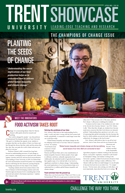On November 12, the Rosetta “comet chaser” mission successfully landed its probe on the surface of Comet 67P/Churyumov–Gerasimenko – a first in space exploration. Now anchored to the surface of the comet, the probe will evaluate samples of the comet to determine its chemical composition and isotope ratios for H, C, N and O.
This information will expand our understanding of the universe and the creation of the earth – and Dr. Raymond March, professor emeritus in Trent’s Chemistry department, has played a key role.
On November 12, follow this historic event via live updates:
http://www.esa.int/Our_Activities/Operations/Live_updates_Rosetta_mission_comet_landing
Professor March has long been a pioneer in the field of mass spectrometry, a technique to identify the chemical composition of an unknown substance. He was one of the first to build a Quadrupole Ion Trap, or QIT, a device that confines and controls ions using radio frequency electric fields — and he built it in the early 1970s within the Science Complex on Trent’s Symons campus, long before the device’s widespread use in industry and academia.
“If you want to know what excitement is, you should have been there,” Prof. March recalls.
The QIT is a vital part of the equipment that will land on the comet that the Rosetta mission is tracking. The model of the QIT in the landing probe is the same size though much lighter than Prof. March’s original model, but his role in pioneering the device’s construction and characterization led to his involvement in the project with the UK Open University and the European Space Agency, the organizations behind the Rosetta project.
More importantly, Prof. March’s work highlights a key strength of Trent’s science faculty: its flexibility as it attempts new projects that are at the cutting edge of their respective fields. Prof. March’s QIT became even more notable in the late 1970s with the addition of graduate student Alison Armitage, who developed a gas chromatograph that could be used in combination with the QIT, doubling the number of mass spectra in a sample that could be analyzed. Mrs. Armitage is now a chemistry teacher in Peterborough, highlighting the depth and connection of Trent’s science community.
The scientific opportunities at Trent continue to grow. When asked for advice for incoming students, Prof. March emphasizes the wide prospects available in the field: “Science is still a very exciting area. It’s very challenging. There have been new discoveries made since the turn of the century, which means there’s a great deal of activity… Biochemistry and medicinal chemistry have just exploded in the last 15-20 years. It’s enormously exciting,” he said.
Posted on Tuesday, November 11, 2014.


































